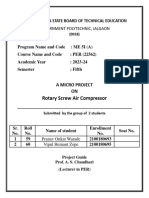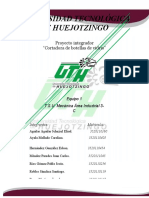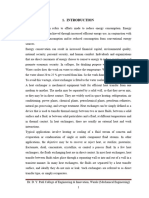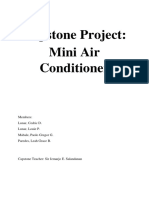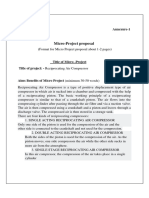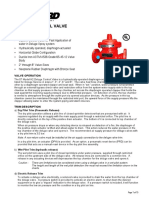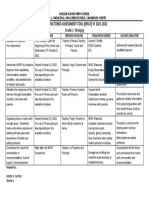PROJECT REPORT
CHAPTER – 1
INTRODUCTION
A mini-project in a polytechnic setting offers students a valuable opportunity to apply
theoretical knowledge to real-world scenarios, fostering practical skills development and
enhancing their understanding of core concepts. Here’s an introduction to a mini-project at a
polytechnic:
In a polytechnic environment, mini-projects serve as a cornerstone of hands-on learning,
allowing students to delve into practical applications of their coursework. These projects
typically involve a focused exploration of a specific topic or problem within their field of
study, encouraging students to research, design, implement, and present their findings.
Whether it’s engineering, computer science, business, or another discipline, mini-projects
provide a platform for students to showcase their creativity, critical thinking, and technical
expertise.Within the context of a polytechnic curriculum, mini-projects often align with the
objectives of the program, addressing key learning outcomes and preparing students for
future academic and professional endeavors. Students may work individually or in teams,
collaborating to tackle complex challenges and deliver innovative solutions. The process
typically involves problem identification, feasibility analysis, project planning, execution,
and evaluation, mirroring real-world project management practices.Mini-projects in a
polytechnic setting can take various forms, including research studies, prototype
development, software applications, business plans, or technical reports. Regardless of the
format, these projects emphasize hands-on learning, experiential discovery, and practical skill
acquisition. Students benefit from mentorship and guidance from faculty members, who
provide expertise, feedback, and support throughout the project lifecycle.
Through mini-projects, students develop a range of competencies essential for success in
their chosen field, including communication skills, teamwork, time management, and
problem-solving abilities. Additionally, these projects offer a valuable opportunity for
students to explore their interests, refine their career goals, and build a portfolio of practical
experience. Overall, mini-projects play a vital role in the polytechnic education landscape,
enriching the learning experience, fostering innovation, and preparing students to become
competent professionals capable of addressing real-world challenges in their respective
industries.
It builds towards the attention of the society, It brings out innovation and creativity. It
enhances problem solving skills.
1
� PROJECT REPORT
CHAPTER – 2
SMART CLASSROOM WORK
In the modern era of education, the evolution of traditional classrooms into smart classrooms
has ushered in a new era of interactive and technology-enhanced learning environments. At
the heart of these innovative spaces are installations such as speaker boxes, projectors, tables,
and window curtains, each playing a pivotal role in shaping the educational experience.
Speaker boxes, strategically positioned throughout the room, ensure that every student can
hear instructions and discussions clearly, fostering an inclusive learning environment.
Projectors, with their ability to display multimedia content, bring lessons to life, captivating
students’ attention and enabling dynamic teaching methods. Tables provide students with
workspace for collaboration and individual tasks, fostering interaction and creativity.
Window curtains control natural light, optimizing visibility for projected content and creating
a comfortable ambiance conducive to learning. Together, these elements synergize to create a
multifaceted learning environment where technology seamlessly integrates with traditional
teaching methods. Through the integration of these installations, smart classrooms empower
educators to engage students in immersive and interactive learning experiences, preparing
them for success in an increasingly digital world.
2.1. EXPENSE OF PROJECT.
2
� PROJECT REPORT
Table. 1.expense of project.
Item. No List of item Estimate
1 Projector stand 2000₹
2 Presentation table 3500₹
3 Curtain 3000₹
4 Amplifier & speaker 10000₹
5 Bluetooth mic 4000₹
6 Cables 1500₹
7 Other items 5000₹
Fig. 1 class room
CHAPTER – 3
HERMETIC COMPRESSORS FOR REFRIGERATION
Hermetic compressors for refrigeration are sealed units containing both the compressor and
motor within a single housing. This design prevents refrigerant leakage and contamination,
ensuring efficient operation. They are commonly used in refrigerators, air conditioners, and
small-scale refrigeration units due to their reliability and compact size. However, in case of
failure, hermetic compressors are not easily repairable and often require replacement of the
entire unit. Regular maintenance is essential for optimal performance.
3
� PROJECT REPORT
Fig.2hermetic compressors for refrigeration
3.1 Parts of Hermetic Compressors For Refrigeration.
1 – Housing with connectors and baseplates.
2 – Top covers.
3 – Block with a stator bracket.
4 – Stators (with screws).
5 – Rotors.
6 – Valve units (screws, cylinder cover, gaskets, valve plate)
7 – Crankshafts with grommet.
8 – Connecting rodes with a piston.
9 – Oil pickup tubes.
10 – Springs with suspensions.
11 – Internal discharge tubes (screw, washer, gasket)
12 – Start equipment (PTC device, cover, cord relief)
4
� PROJECT REPORT
Fig. 3 Parts of Hermetic Compressors For Refrigeration
3.2 The Compressor, Its Components, and Their Function
Type label
The type label that can be found on every hermetic compressor contains critical information
for the customer or user, as well as for the dispatch process. Details include the type of
compressor, the refrigerant which it is designed for, the frequency, and the mains voltage.
Connectors
The suction connector is used to suck the refrigerant into the compressor with the process and
discharge connectors located on opposite sides. Compressed refrigerant is discharged from
the compressor via the discharge connector. The process connector allows the cooling system
to be charged with refrigerant after the compressor has been
installed. This process would usually take place in a final stage at the manufacturer’s
assembly line.
Electrical connection
5
� PROJECT REPORT
The electrical connection can be seen on the outside of the compressor. Depending upon the
type of device being purchased, starting equipment is sometimes preassembled together with
an appropriate protective plastic cover.
Compressor housing
The compressor shell is constructed from a steel sheet with the top cover welded together
with the bottom housing. That connection is hermetically sealed, ensuring that refrigerant
cannot leak to the outside. In order to guarantee that the mechanical unit (motor, cylinder, and
valve) of the hermetic compressor remains within the center of its housing, four springs are
used to keep it in its dedicated position. The external interfaces of the shell include two
baseplates that enable the compressor to be mounted within the appliance.
Motor and stator
The motor is of key importance to the compressor and consists of a stator, rotor, and power
cable. It is a priority to ensure that noise levels are kept to a minimum, and the motor is
mounted on springs for this reason which results in reduced levels of vibration.
The stator consists of a stator stack, together with two windings of copper wires. The stator
stack is constructed using sheet metal. The windings are suitably protected to ensure that
damage from loose wires can be avoided. By contrast, the rotor has an iron core, cast in
aluminum.
Electrical start equipment
The provided electrical starting device must be suitable for the individual compressor. The
starting device is responsible for starting the hermetic compressor and does so by supplying
the necessary power to enable the start winding to be activated. Once the
compressor has started to rotate, power is supplied via the motor to the main winding. A
flexible connection to the motor is provided via the power cable.
Pump unit
The piston and cylinder unit contains four distinct elements: a block, discharge tube,
crankshaft, and piston. The discharge tube is mounted upon the block, with an oil pump
mounted at the bottom of the crankshaft. The piston has a piston rod which is connected via a
6
� PROJECT REPORT
piston pin. Two discharge chambers are contained within the block and are used to enable
compressed refrigerant to make its way to the discharge connector.
The flexibility of the tube itself is increased by turns of the discharge tube. The crankshaft is
securely connected to the rotor, transforming the rotations of the motor into strokes of the
piston. As a result of these piston strokes, the cylinder moves up and down. It’s this
movement that allows refrigerant to be sucked in, then compressed, and finally discharged.
The valve unit makes use of a discharge valve and suction unit, which are both installed on
the main valve plate. The valves assist with opening and closing the valve plates during the
suction and discharge processes. This action allows the hermetically compressed refrigerant
to make its way into the discharge chambers. Finally, a muffler is used to reduce the noise
that is created by the suction process. It is fitted between the suction connector and the
suction side of the pump unit.
3.3 Advantages.
Simple design and easy installation.
Fewer external connections, making it less prone to leaks.
Cost-effective and widely used in residential applications.
7
� PROJECT REPORT
CHAPTER – 4
CONDENSER FOR REFRIGERATION
The condenser is an important device used in the high pressure side of a refrigeration system.
Its main function is to transfer heat from the refrigeration system to condensing medium. The
Hot vapour refrigerant consists of the heat absorbed in the evaporator and the heat of
Compression added by the mechanical energy of the compressor. The heat from the hot
Vapour refrigerant in a condenser is removed first by transferring it to the walls of the
Condenser tubes and then from the tubes to the condensing or cooling medium. The cooling
Medium may be air or water or a combination of the two. The selection of a condenser
Depends upon the capacity of the refrigerating system, the type of refrigerant used and the
Types of cooling medium available.
Fig. 4 Condenser
8
� PROJECT REPORT
4.1.Working of condenser.
The condenser, or condenser coil, is one of two types of heat exchangers used in a
basic refrigeration loop. This component is supplied with high-temperature high-pressure,
vaporized refrigerant coming off the compressor. The condenser removes heat from the hot
refrigerant vapor gas vapor until it condenses into a saturated liquid state, a.k.a. condensation.
After condensing, the refrigerant is a high-pressure, low-temperature liquid, at which point
it’s routed to the loop’s expansion device.
Fig. 5 working of condenser
9
� PROJECT REPORT
CHAPTER – 5
CAPILLARY TUBES
Capillary tube is one of the commonly used throttling devices in the refrigeration and the air
conditioning systems. The capillary tube is made up of copper tube of very small internal
diameter. It is of very long length and it is coiled to several turns so that it occupies less space
Fig.6 capillary tubes
5.1 working of capillary tube in refrigeration.
In refrigeration systems, the capillary tube serves as a crucial component for regulating the
flow of refrigerant. Positioned between the high-pressure and low-pressure sides of the
system, it acts as a metering device. As the high-pressure liquid refrigerant enters the
capillary tube, its narrow diameter causes a significant pressure drop. This drop in pressure
10
� PROJECT REPORT
allows the refrigerant to expand rapidly, transforming into a mixture of liquid and vapor. This
cooled and expanded refrigerant then enters the evaporator coil, where
it absorbs heat from the surrounding environment, thereby cooling it down. By precisely
controlling the flow of refrigerant, the capillary tube helps maintain the desired temperature
inside the refrigeration system.
Fig. 7 working of capillary tubes
11
� PROJECT REPORT
CHAPTER – 6
CONCLUSION
For the conclusion of your mini project on refrigeration parts disassembled and reassembled ,
you could summarize the key findings and insights gained from the process. This might
include:
Understanding of Components:
Discuss the various components of the refrigeration system that you disassembled and
reassembled, such as the compressor, condenser and capillary tube.
Assembly Process:
Explain the steps involved in disassembling and reassembling the system,
highlighting any challenges faced or lessons learned during the process.
Functionality:
Reflect on how each component contributes to the overall functionality of the
refrigeration system and how they work together to achieve the desired cooling effect.
Skills Development:
Share how this project helped you develop practical skills in handling refrigeration
systems, troubleshooting issues, and performing repairs or maintenance tasks.
Future Applications:
Discuss how the knowledge and experience gained from this mini project could be
applied in real-world scenarios, such as in a professional setting or future academic
projects.
By including these points in your conclusion, you can provide a comprehensive summary
of your mini project on refrigeration.
12
� PROJECT REPORT
CHAPTER – 7
REFERENCE
https://www.secop.com/products/hermetic-compressors-basics
https://www.superradiatorcoils.com/blog/4-main-refrigeration-cycle-components
https://www.swep.net/refrigerant-handbook/4.-expansion-valves/adf4/
13

















